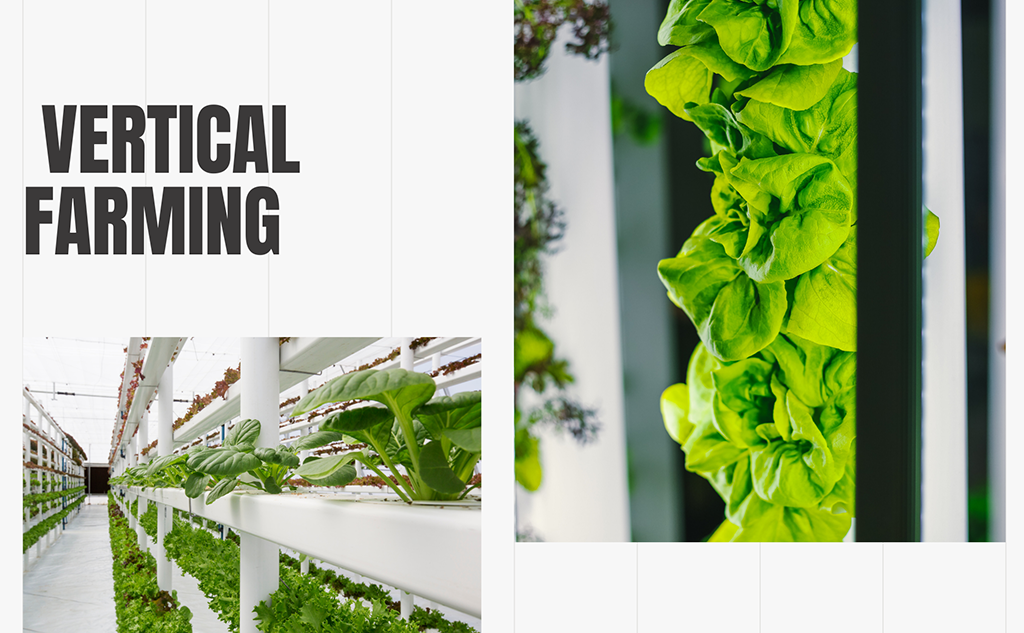Episodes of drought are multiplying, soils are becoming poorer, arable land is becoming rarer, and the world’s population continues to grow, reaching 9.7 billion by 2050 according to the UN, 70% of whom will be living in cities. Against this backdrop, the question arises as to whether traditional agriculture will still be able to ensure food security for the world’s populations.
Faced with the challenges posed by climate change and growing urbanization, a new model of agriculture has been developing over the last few years: vertical farming, a method of cultivation that not only considerably reduces production’s footprint on the ground and increases yields, but also preserves the environment and water resources.
What is vertical farming?
Vertical farming is a food production system that involves growing vegetables, herbs and other plants in overlapping layers. Unlike traditional agriculture, which occupies horizontal space, this method of above-ground cultivation uses vertical space by arranging plants on shelves or vertical rows of cylinders, for example.
This technique is particularly suited to urban agriculture, where space is limited. It is most often used indoors, in a controlled environment where lighting, temperature, humidity, ventilation and plant nutrition are regulated by artificial intelligence. Vegetables are thus protected from weather conditions, disease and parasites, and have optimum conditions for year-round growth.
The concept of vertical farming was popularized in the early 2000s by microbiologist and professor Dickson Despommier. He was looking for an alternative to traditional agriculture to meet the challenges posed by increasing urbanization, climate change and the need to produce more food in limited spaces.
Key benefits of vertical farming
Agriculture in a controlled environment offers a number of advantages:
- Space optimization: vertical farming reduces production space and allows more vegetables to be grown per square meter than traditional agriculture.
- Preservation of water resources: the irrigation systems used generally operate in closed circuits, enabling water to be reused and reducing the use of this vital resource.
- Higher yields and faster production: the controlled environment enables continuous, year-round production, protected from weather conditions, pathogens and pests.
- Minimal environmental impact: this method of farming helps to reduce greenhouse gas emissions by cutting down on the need for transport, since it makes urban farming possible and encourages short supply chains, from production to consumer. It also reduces or eliminates the need for chemical inputs (pesticides, fungicides, herbicides, etc.).
What technologies are used in vertical farming?
Vertical farming incorporates several advanced technologies to maximize efficiency and yields. These include hydroponics and aquaponics.
Hydroponics is a method of growing vegetables not in soil, but in water with the addition of the nutrients they need. The plants are placed on a neutral substrate (sand, pozzolan, clay balls, rock wool, etc.), which serves as a support and is irrigated by the nutrient solution.
Aquaponics combines aquaculture (fish farming) and hydroponics. In this closed-loop production system, fish and plants live in symbiosis: the waste produced by the fish is transformed by bacteria into nutrients that can be directly assimilated by the plants. In return, the plants filter and purify the water, which returns to the fish tank.
Both cultivation methods generally use automated climate control systems. Sensors, probes, horticultural LEDs, remote connectivity and software platforms enable precise adjustment of nutrient levels (in the case of hydroponics), pH, temperature, lighting or humidity levels, for optimal fruit and vegetable growth.
Vertical farming, present worldwide
Around the world, in Asia, North America and Europe, vertical farms continue to expand.
In North America, for example, the Plenty company recently opened a farm in Compton, California, which should eventually be able to produce almost 2,000 tonnes of leafy vegetables on an area the size of just one city block.
In 2012, the first commercial vertical farm was created in Singapore, by Sky Greens, and redesigned the urban landscape with its 120 aluminum towers, 9 metres high (38 storeys). In this archipelago, the vast majority of food is imported, and the population density is over 7,000 inhabitants per square kilometer. With yields eight times higher than the same area cultivated in traditional farming, the farm contributes to the “city-state’s” goal of food self-sufficiency.
Jungle is France’s first and largest vertical farm. In this 4,000 m2 warehouse in Château-Thierry, Aisne, lettuce, basil, parsley, chives, mint, dill, coriander and wasabi are grown aquaponically in 11-meter-high chambers. This model of controlled-environment agriculture enables the company to harvest basil 14 times a year, compared with 3 or 4 times in traditional agriculture. According to Gilles Dreyfus, president and co-founder of the farm, it also eliminates the need for pesticides, herbicides and fungicides, and ensures optimal plant taste and nutrient content.
Although they don’t always take advantage of vertical space, green roofs also offer great opportunities. The 14,000 m2 roof of Pavilion 6 at Paris Expo, Porte de Versailles, for example, is home to NATURE URBAINE, Europe’s largest rooftop urban farm. By 2021, the farm was only operating on 4,500 m2, but its 696 columns and 1,428 gutters were already harvesting 200 kilos of fruit and vegetables a day.
Vertical farming, the agriculture of tomorrow?
Against a backdrop of climate change, urbanization and an ever-growing population, vertical farming is opening up new horizons. This mode of production, which significantly reduces the amount of land used for farming, transport, chemical inputs and water resources, is more respectful of the environment and also plays a role in boosting the resilience of populations.
Integrating vertical agriculture into urban sustainable development policies offers cities the opportunity to improve food security for their inhabitants. This approach fits perfectly with the concept of smart, sustainable cities, offering a viable solution for feeding a growing urban population while preserving natural resources.




